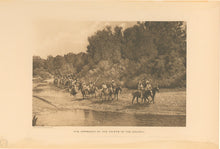Joseph K. Dixon. "The Approach of the Chiefs to the Council." From The Vanishing Race: The Last Great Council.
New York: Doubleday, Page & Co. 1913. Photogravure printed in sepia. Octavo. Approximately 4 x 6. Fine condition.
(Lewis) Rodman Wanamaker (1863–1928) was a son of Philadelphia department store founder John Wanamaker. In 1886, Rodman joined the family business and worked in Europe until 1896 when he was brought to New York. When John Wanamaker died in 1922, Rodman assumed control of the firm. Besides his association with the Wanamaker stores, Rodman is credited with financing the development of the first seaplane and the Professional Golfers Association.
Between 1908 and 1913, the younger Wanamaker sponsored three expeditions to the American Indians intended to document Indian life and culture through photography, moving film, and sound recordings. Rodman supported the idea to give Native American Indians the right to citizenship. He hired Joseph K. Dixon, who worked in the education department at Wanamaker’s, to photograph the Indians. Dixon took over eight thousand photographs. Most of these images were staged and appear overly sentimental, but they reflect Rodman’s sympathy with the Indians. These photographs, like those of William Curtis which were published a few years earlier, are an interesting visual record of American Indians at the time.





